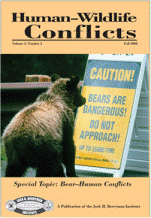Center, Internet, Wildlife Damage Management

Human–Wildlife Interactions
Date of this Version
2008
Document Type
Article
Abstract
As urban landscapes expand across the globe, it becomes imperative to understand how these landscapes affect large carnivore populations. We examined the effects of human-altered landscapes on age-specific fecundity and life history parameters for female black bears (Ursus americanus) in urban and wildland regions in the northern Sierra Nevada Mountains of Nevada, including the Lake Tahoe Basin. We followed 12 marked female bears in an urban environment and 10 females in wildland habitats from 1997–2006. Our results show that female bears in urban areas have higher age-specific fecundity rates than did wildland female bears. Despite this difference, female bears in urban areas never realized this putative gain in fitness because they experienced higher age-specific mortality rates, leading to the creation of sinks (λ = 0.749). Urban bears of the Lake Tahoe Basin are unable to repopulate vacated wildland areas.


Comments
Published in Human–Wildlife Conflicts Volume 2, Number 2, Pages 168-174, Fall 2008. Published and copyright by Jack H. Berryman Institute http://www.berrymaninstitute.org/journal/index.html